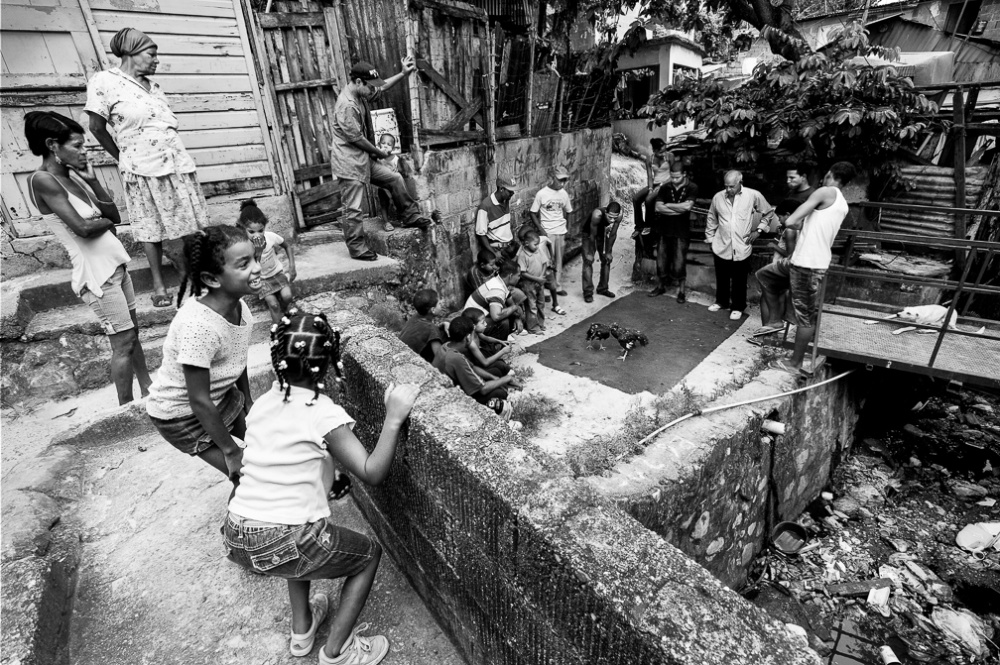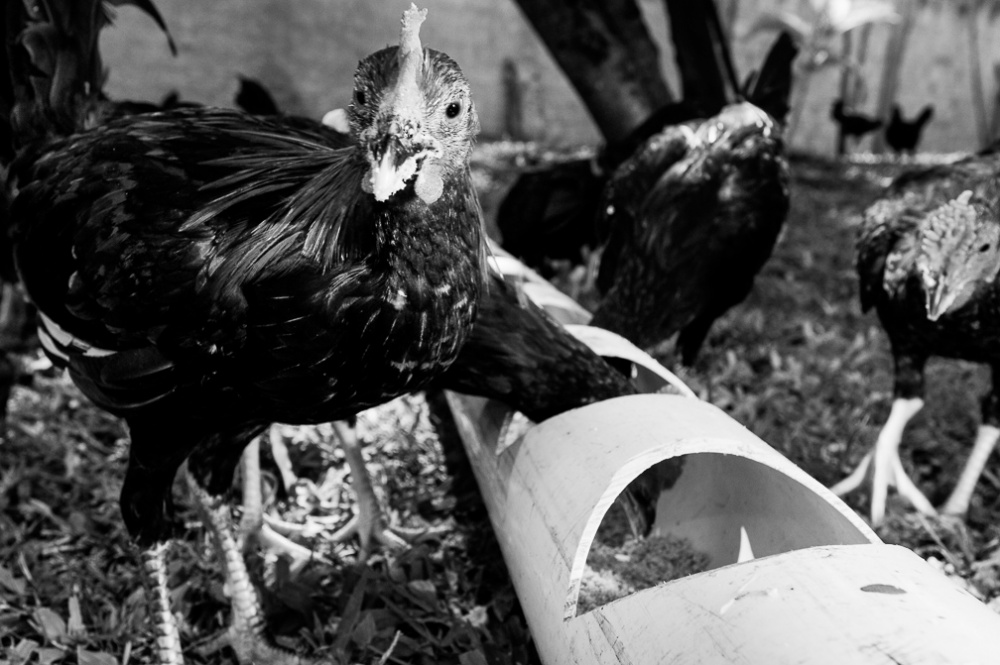Meeting Spot
Meeting Spot is an ongoing photography project about cockfighting in Santo Domingo, the capital of the Dominican Republic and how through this national sport, Dominican men are united despite any social, economical and educational differences—because they share a passion in common.
While, I am not in favor of animal cruelty, I am interested in learning about the sport and exploring how it brings about union within the Dominican community of men, who reside in a country where racism, classism and modern slavery still exist. Meeting Spot consists of two parts: 1) a depiction of the transformation of the young rooster to the gamecock: the training, the preparation of the fight and finally the cruel death; 2) the exploration of the sport of cockfighting as one that brings together men from different social classes—in what normally would be a classist hierarchically divided culture—during fights at one of the three Coliseums in the Dominican Republic.
Cockfighting is a national sport in the Dominican Republic that generates 500 million pesos a year, the equivalent of 12,680,700.00 US Dollars. Unlike in the United States, cockfighting is legal in the Dominican Republic since 1973, when ex-president Joaquín Balaguer inaugurated the first legal cockfight in the Santo Domingo Coliseum Alberto Bonetty Burgos. Cockfighting is a combat sport between two roosters (cocks or gamecocks) held in a ring called a cockpit or at a Coliseum during the Championships. The winner is the surviving rooster. However, the owner of the losing gamecock can decide to forfeit the game by throwing a white flag or towel as a symbol of surrender in order to save the defeated rooster. In this sport, the athletes are the roosters and the owners are enthusiasts and gamblers. A champion rooster or gamecock has to win 16 or more cockfights in order to become a father or padrote, which means that he will breed more champion chicks. Prior to fighting, the roosters are raised and trained in a place known as “trabas”. A champion rooster wins thousands of dollars per fight.
The sport is regulated by the Ministry of Sports in the country and by the Town Hall of each municipality. In order for cockpits to be considered legal in the Dominican Republic, they must be registered at SEDEFIR—State Secretary Department of Sports, Physical Education and Recreation in the capital of Santo Domingo. All legal cockpits and cockfighting coliseums pay taxes to the Dominican Government, which adds to a lot of money. Today, there are 76 registered cockpits in the Dominican Republic. However, there are also many illegal ones in the city, known as “underground cockpits”. In addition, there are three Coliseums, where in addition to regular cockpit fights, the final championships take place—all of whom are owned by Edmond Elias Enterprises (EE), the biggest land based casino operator in the Dominican Republic. One of them is the Cockfighting Coliseum of Santo Domingo. Inside a Coliseum you can find men from diverse social classes, including educational and economical differences, which are set aside or ignored for the duration of the fights. Their point of convergence is the passion they share for the sport.
It is known to the Dominican people that past presidents, musicians, painters, accountants, lawyers, wealthy and well-known people of high-class society have been enthusiasts of this sport. However, it really doesn’t matter whether one is born into money, won the lottery, or is from a humble background. As long as the gambler can keep his word, he is accepted into any Cockpit as well as the Coliseum. There is no ticket or receipt that will attest your bet; once the enthusiastic gambler verbally places the bet on his gamecock, he must keep his word. That being said, in every cockpit and Coliseum, there are employees in charge of keeping track of the bets placed and who make sure the bets are paid off.
In 2009, I traveled to Santo Domingo to research what I thought was the coming to end of this sport. Until then, I was assured that there was a big movement trying to make cockfighting illegal. During my visit, I learned that the sport was not even close to being banned for it is integrated in the Dominican culture. As a result, I decided to explore and document the bloody sport as a cultural patrimony. Since, I have returned numerous times to document illegal and legal cockfighting at cockpits and Coliseum, as well as, interview key players in the sport. Although many wealthy men participate in cockfighting, this is one sport that does not discriminate against one's social class.
The project, “Meeting Spot” takes place in various locations in Santo Domingo, the capital of the Dominican Republic: Traba Maunaloa, which belongs to Edmond Elias; Traba Manoguayabo, which belongs to Captain Juan la Chiva; la Gallera Manoguallabo; and, two others. In addition to depicting the sport, this project narrates the story of three cockfighting enthusiasts:
Moreno, a young Dominican boy from a humble upbringing, who keeps his only rooster in his mother’s house, located in Herrera, one the most dangerous “barrios” in the city.
- Rafael Lora, a middle-aged accountant and family man, who is a middle class worker and a loyal VIP member of the Coliseum.
- Willy Pérez, the son of a famous and wealthy painter, who describes the rooster as a symbol of strength and courage to the Dominican people. For years, Pérez has painted roosters and sold the work. Like his father, he depicts the subject of cockfighting in his paintings.
These stories are accompanied with audio interviews of: Edmond Elias (son), an architect and businessman, Freddy, an employee of Edmond Elias and caretaker of his “traba” and rooster and Cheo, an unemployed man with no education.
Winning this grant will help me fund the investigation of this on going proyect in the Dominican Republic as well as other latin american countries.

























